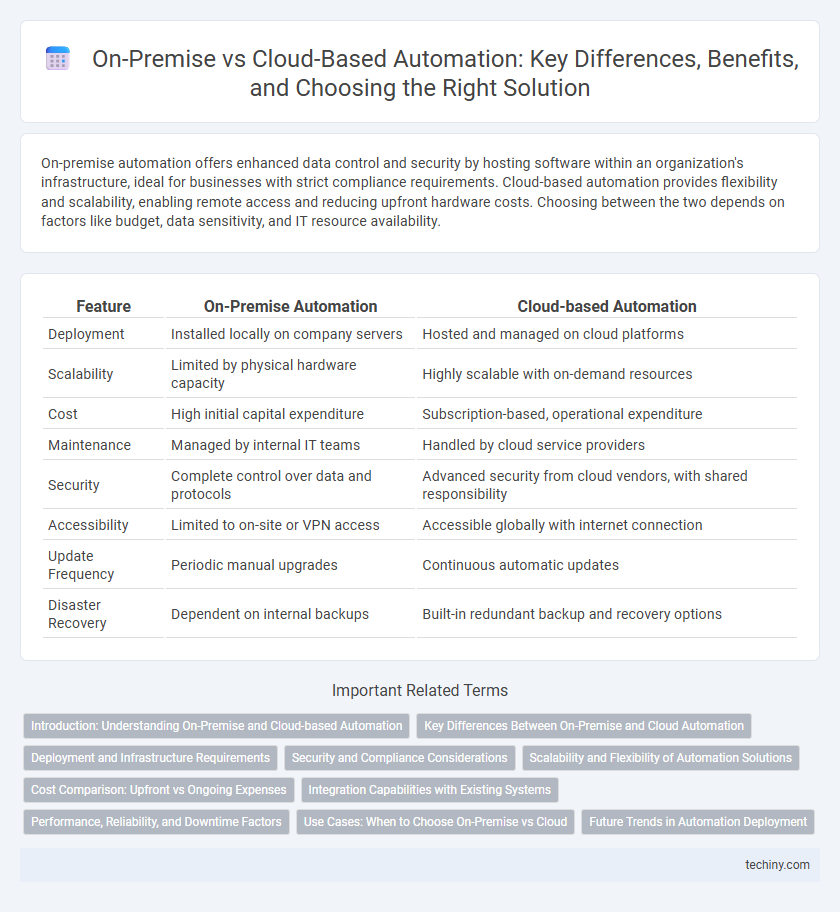On-premise automation offers enhanced data control and security by hosting software within an organization's infrastructure, ideal for businesses with strict compliance requirements. Cloud-based automation provides flexibility and scalability, enabling remote access and reducing upfront hardware costs. Choosing between the two depends on factors like budget, data sensitivity, and IT resource availability.
Table of Comparison
| Feature | On-Premise Automation | Cloud-based Automation |
|---|---|---|
| Deployment | Installed locally on company servers | Hosted and managed on cloud platforms |
| Scalability | Limited by physical hardware capacity | Highly scalable with on-demand resources |
| Cost | High initial capital expenditure | Subscription-based, operational expenditure |
| Maintenance | Managed by internal IT teams | Handled by cloud service providers |
| Security | Complete control over data and protocols | Advanced security from cloud vendors, with shared responsibility |
| Accessibility | Limited to on-site or VPN access | Accessible globally with internet connection |
| Update Frequency | Periodic manual upgrades | Continuous automatic updates |
| Disaster Recovery | Dependent on internal backups | Built-in redundant backup and recovery options |
Introduction: Understanding On-Premise and Cloud-based Automation
On-premise automation involves deploying software and hardware within a company's physical location, offering greater control over data security and system customization. Cloud-based automation leverages internet-hosted platforms, enabling scalable, flexible access without extensive upfront infrastructure costs. Choosing between these models depends on factors like compliance requirements, budget, and IT resource availability.
Key Differences Between On-Premise and Cloud Automation
On-premise automation requires local infrastructure management, offering greater control and customization, while cloud-based automation provides scalability and remote accessibility through third-party servers. On-premise solutions often involve higher upfront costs and maintenance responsibilities, whereas cloud automation operates on subscription models with lower initial investments. Security and compliance vary, with on-premise enabling direct oversight of data, and cloud automation relying on provider-level protections and certifications.
Deployment and Infrastructure Requirements
On-premise automation requires significant investment in physical infrastructure, including servers, networking, and maintenance, ensuring complete control over deployment but demanding in-house IT expertise. Cloud-based automation leverages scalable, remote infrastructure managed by service providers, enabling rapid deployment with minimal upfront costs and flexible resource allocation. Choosing between on-premise and cloud hinges on an organization's need for control, security, and scalability in automation infrastructure.
Security and Compliance Considerations
On-premise automation solutions provide organizations with direct control over data security, enabling tailored compliance with industry-specific regulations such as GDPR, HIPAA, and PCI-DSS. Cloud-based automation platforms offer robust security protocols including encryption, multi-factor authentication, and regular audits, yet require thorough evaluation of vendor compliance certifications and data residency policies. Businesses must assess their risk tolerance, regulatory requirements, and internal security capabilities to determine the optimal automation deployment strategy.
Scalability and Flexibility of Automation Solutions
On-premise automation solutions offer controlled scalability limited by local hardware capacity, requiring significant upfront investment for upgrades. Cloud-based automation provides dynamic scalability with virtually unlimited resources, enabling rapid adaptation to fluctuating workloads and business demands. Flexibility in cloud automation supports seamless integration and on-demand customization, contrasting with the more rigid infrastructure constraints of on-premise setups.
Cost Comparison: Upfront vs Ongoing Expenses
On-premise automation demands significant upfront capital investment in hardware, software licenses, and infrastructure maintenance, leading to higher initial costs. Cloud-based automation typically operates on a subscription or pay-as-you-go model, reducing upfront expenses but incurring ongoing operational fees tied to usage and service levels. Over time, cloud solutions often result in lower total cost of ownership by eliminating hardware depreciation and minimizing IT staff requirements.
Integration Capabilities with Existing Systems
On-premise automation offers direct integration with legacy systems through localized networks, enabling faster data exchange and enhanced security control. Cloud-based automation provides scalable API-driven integration, supporting diverse platforms and real-time data synchronization across distributed environments. Selecting the appropriate solution depends on existing infrastructure complexity, required flexibility, and data governance requirements.
Performance, Reliability, and Downtime Factors
On-premise automation systems typically offer superior performance due to dedicated hardware and localized data processing, reducing latency and enhancing control over system resources. Cloud-based automation provides higher reliability through redundant infrastructure and automatic failover mechanisms, minimizing downtime with scalable resources and global data centers. Downtime in on-premise setups often results from hardware failures or maintenance, while cloud-based solutions mitigate this risk with distributed backups and continuous monitoring.
Use Cases: When to Choose On-Premise vs Cloud
On-premise automation suits industries with strict data security requirements such as healthcare, finance, and government, where sensitive information must remain within the organization's firewall. Cloud-based automation excels in scalable, collaborative environments like e-commerce, software development, and global supply chains, offering flexibility and reduced infrastructure costs. Organizations should choose on-premise when control, customization, and compliance are priorities, while cloud automation is ideal for rapid deployment, remote access, and cost efficiency.
Future Trends in Automation Deployment
Future trends in automation deployment emphasize a hybrid approach combining on-premise infrastructure with cloud-based solutions to maximize flexibility and scalability. Edge computing advancements will drive on-premise automation for real-time processing, while cloud platforms will enhance AI integration, analytics, and remote management capabilities. Organizations will increasingly adopt multi-cloud strategies to optimize cost efficiency, security, and compliance in automation systems.
On-Premise vs Cloud-based Automation Infographic

 techiny.com
techiny.com